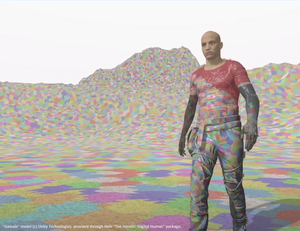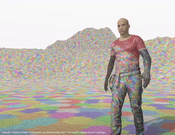Information
- Publication Type: Journal Paper with Conference Talk
- Workgroup(s)/Project(s):
- Date: October 2021
- Journal: Computer Graphics Forum
- Volume: 40
- Open Access: yes
- Number: 7
- Location: online
- Lecturer: Johannes Unterguggenberger
- ISSN: 1467-8659
- Event: Pacific Graphics 2021
- DOI: 10.1111/cgf.14401
- Call for Papers: Call for Paper
- Booktitle: Computer Graphics Forum
- Pages: 13
- Publisher: Eurographics Association
- Conference date: 18. October 2021 – 21. October 2021
- Pages: 57 – 69
- Keywords: real-time rendering, meshlet, mesh shader, task shader, view frustum culling, backface culling, Vulkan, vertex skinning, animation, conservative bounds, bounding boxes, Rodrigues' rotation formula, spatio-temporal bounds
Abstract
Following recent advances in GPU hardware development and newly introduced rendering pipeline extensions, the segmentation of input geometry into small geometry clusters-so-called meshlets-has emerged as an important practice for efficient rendering of complex 3D models. Meshlets can be processed efficiently using mesh shaders on modern graphics processing units, in order to achieve streamlined geometry processing in just two tightly coupled shader stages that allow for dynamic workload manipulation in-between. The additional granularity layer between entire models and individual triangles enables new opportunities for fine-grained visibility culling methods. However, in contrast to static models, view frustum and backface culling on a per-meshlet basis for skinned, animated models are difficult to achieve while respecting the conservative spatio-temporal bounds that are required for robust rendering results. In this paper, we describe a solution for computing and exploiting relevant conservative bounds for culling meshlets of models that are animated using linear blend skinning. By enabling visibility culling for animated meshlets, our approach can help to improve rendering performance and alleviate bottlenecks in the notoriously performanceand memory-intensive skeletal animation pipelines of modern real-time graphics applications.Additional Files and Images
Additional images and videos
Additional files
 paper:
Conservative Meshlet Bounds for Robust Culling of Skinned Meshes
paper:
Conservative Meshlet Bounds for Robust Culling of Skinned Meshes
 slides:
Slides used for the talk
slides:
Slides used for the talk
Weblinks
- Entry in reposiTUm (TU Wien Publication Database)
- Entry in the publication database of TU-Wien
- DOI: 10.1111/cgf.14401
BibTeX
@article{unterguggenberger-2021-msh,
title = "Conservative Meshlet Bounds for Robust Culling of Skinned
Meshes",
author = "Johannes Unterguggenberger and Bernhard Kerbl and Jakob
Pernsteiner and Michael Wimmer",
year = "2021",
abstract = "Following recent advances in GPU hardware development and
newly introduced rendering pipeline extensions, the
segmentation of input geometry into small geometry
clusters-so-called meshlets-has emerged as an important
practice for efficient rendering of complex 3D models.
Meshlets can be processed efficiently using mesh shaders on
modern graphics processing units, in order to achieve
streamlined geometry processing in just two tightly coupled
shader stages that allow for dynamic workload manipulation
in-between. The additional granularity layer between entire
models and individual triangles enables new opportunities
for fine-grained visibility culling methods. However, in
contrast to static models, view frustum and backface culling
on a per-meshlet basis for skinned, animated models are
difficult to achieve while respecting the conservative
spatio-temporal bounds that are required for robust
rendering results. In this paper, we describe a solution for
computing and exploiting relevant conservative bounds for
culling meshlets of models that are animated using linear
blend skinning. By enabling visibility culling for animated
meshlets, our approach can help to improve rendering
performance and alleviate bottlenecks in the notoriously
performanceand memory-intensive skeletal animation pipelines
of modern real-time graphics applications.",
month = oct,
journal = "Computer Graphics Forum",
volume = "40",
number = "7",
issn = "1467-8659",
doi = "10.1111/cgf.14401",
booktitle = "Computer Graphics Forum",
pages = "13",
publisher = "Eurographics Association",
pages = "57--69",
keywords = "real-time rendering, meshlet, mesh shader, task shader, view
frustum culling, backface culling, Vulkan, vertex skinning,
animation, conservative bounds, bounding boxes, Rodrigues'
rotation formula, spatio-temporal bounds",
URL = "https://www.cg.tuwien.ac.at/research/publications/2021/unterguggenberger-2021-msh/",
}


 paper
paper